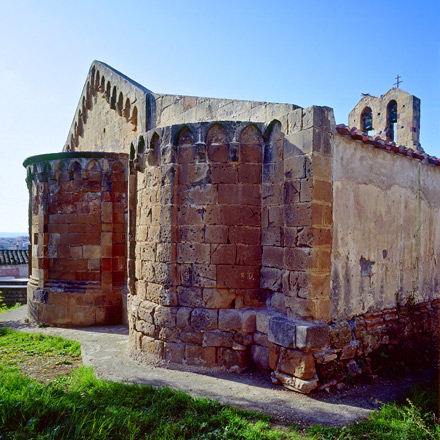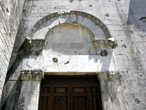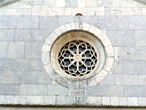The Church
At the heart of upper Versilia, at the gates of the inhabited centre of Stazzema, in the municipal territory where a tragic Nazi slaughter occurred in August 1944, the pieve of Santa Maria Assunta rises in an isolated position, turning its back to the road, its front overlooking the crag at whose foothills the stream Vezza flows.
In the edifice, subsequent work stages may be identified, revealing the ever-increasing importance of the area in medieval and post-medieval times, up to the elevation of the church to the rank of pieve in 1652. Built as a single-nave edifice on the model of the pieve of Valdicastello, to which the church was originally subordinate, it was completed by aisles and adjacent rooms through the centuries; the back of the building was changed and the bell tower was built over again many times, yet preserving an overall harmony that has kept the interest and the evocative power of the place intact.
Description »
The building presents a three-nave plan marked by round-arch arcades, resting on monolithic columns; it has no apse, probably due to an enlargement process started since the 15th century, which included the addition of aisles with a vaulted ceiling, the creation of the coffered ceiling over the nave, the enlargement of the presbyterial area and, perhaps, the modifications on the back part.
The external masonry consists of regular courses of squared ashlars in white limestone, reused with a similar, though less regular, technique in post-medieval enlargements as well. Three portals open on the façade, in addition to two side oculi and a central rose window; the central part dates back to the 12th century, except for the rose window, referring to the 15th century; above, it is completed by monolithic Lombard bands resting on corbels, decorated by zoomorphic figures, analogous to those adorning the archivolt of the main portal. The whole decoration was made by hand of the same workers who performed the sculptural decoration of Valdicastello pieve.
The open gallery on the left section of the façade was created in 1601, while the present bell tower was built in the mid-18th century.
History »
In the earliest document referring to the church, dated 876, it appears as subordinate from the pieve of S. Felicita in Valdicastello. Such dependence may be hardly explained when considering the present communication routes; actually, it was easily motivated by the geographic nearness of the two localities, sited at a few kilometres from each other and connected by ancient road networks. Like the pieve of Valdicastello, also the present church of S. Maria Assunta was built in the 12th century, with reference to the nave and the corresponding section of the façade. To reassert this link, the sculptural decoration of this part of the façade was performed by the same workers who made such a similar one in Valdicastello.
In the following centuries, the locality thrived thanks to the exploitation of local mining resources and a wise strategy of political alliances, which would eventually lead it, in the 15th century, to enter the Florentine dominion. That date also marks the enlargement process of the building; despite of several adverse pressures, it was still formally subordinate to the pieve of Valdicastello until 1652, belonging to Lucca diocese until the 18th century. In 1788, the pieve of S. Maria Assunta would pass under Pisa diocese, along with the other pievi of Upper Versilia.
Works »
The church also hosts a painting on wood depicting an Assumption of the Virgin by Pietro di Talata (already known as Maestro di Borsigliana), performed around 1460 and placed on the high altar until the 17th century.
Restorations »
Like many other ones in the area, the building was damaged by an earthquake of the early 1920’s. Following such event, restoration works involved the reconstruction of the partially crumbled bell tower, the consolidation of the load-bearing structures and the repair of the vault system covering the aisles, which had parted from the side walls supporting it.
Bibliography »
M.P. Gavioli Andres, L. Luisi Galleni, Pievi romaniche della Versilia: itinerari storico- artistici, Lucca 1999, pp. 93-105.
M.T. Filieri, S. Russo (a cura di), La piana lucchese e la Versilia, Milano 2000, pp. 142-144.
Location
























 Apse
Apse
 Diocese
Diocese Archivolt
Archivolt
 Portal
Portal
 Nave/Aisles
Nave/Aisles
 Rose window
Rose window





